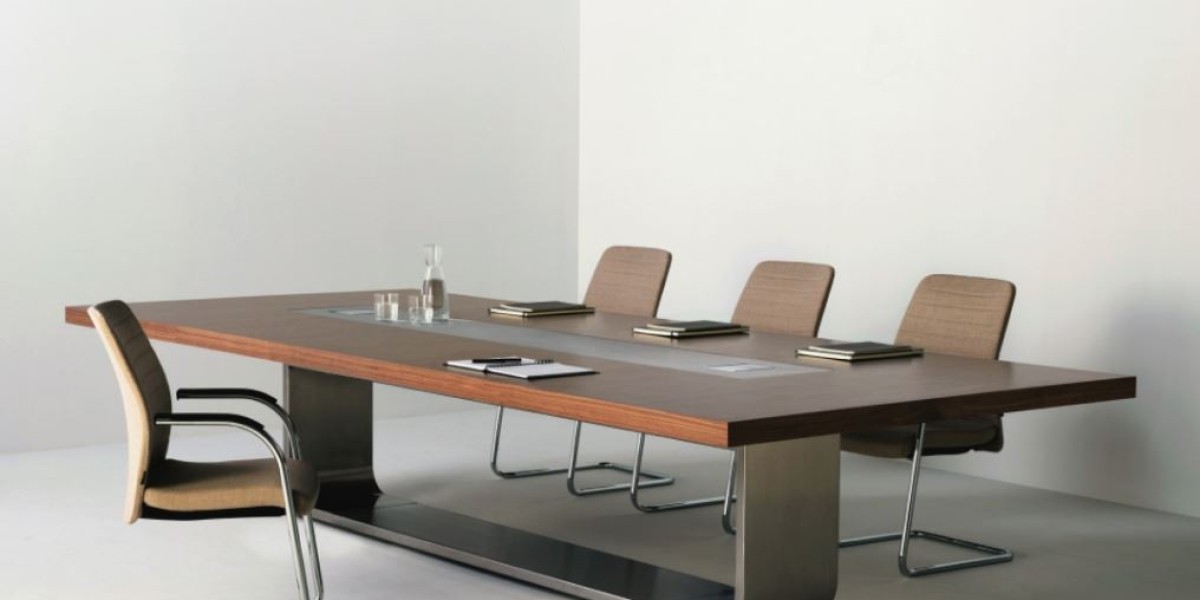In today’s evolving corporate world, the functionality and aesthetics of office furniture play a significant role in defining work culture and productivity. Among the most vital pieces in any workplace is the conference table. It is not just a piece of furniture, but the centerpiece of collaboration, discussion, and decision-making. Understanding proper conference table dimensions is critical for maximizing comfort, space efficiency, and overall meeting effectiveness. Whether you are furnishing a small startup office or designing a luxurious boardroom for a large corporation, getting the size and proportions right can dramatically impact your meeting experience. Conference rooms come in various layouts, and the table must align with the room size, number of users, and technological needs.
Ideal Conference Table Sizes Based on Room Dimensions
When planning a conference room, one of the first aspects to consider is the size of the room. Proper spacing around the table ensures that attendees can move freely, chairs can be pulled in and out with ease, and participants don’t feel cramped. As a general guideline, a minimum of 3 feet clearance from the wall on all sides of the table should be maintained. For instance, a room measuring 12 feet by 16 feet can typically accommodate a table that is about 6 feet long and seats six to eight people comfortably. Larger rooms measuring 20 feet by 30 feet can accommodate conference tables that are up to 20 feet in length, seating 18 or more participants. These conference table dimensions ensure the room feels balanced and allows smooth traffic flow, creating a professional and functional atmosphere.
Seating Capacity and Table Shape: A Balanced Approach
The shape of the conference table also affects how many people it can seat and how comfortably they can interact. Rectangular tables are the most traditional and provide a formal look, offering the highest seating capacity for their size. A rectangular table that is 10 feet long can typically seat 10 people, while one that is 20 feet long can accommodate up to 20 attendees. Round tables promote equality and inclusion, making them suitable for smaller teams or brainstorming sessions. A 60-inch round table, for example, generally seats four to six people. Boat-shaped and racetrack tables combine the formality of rectangular tables with a softer visual appeal and can seat a similar number of people as rectangular ones of equal length. Choosing the right shape in tandem with ideal conference table dimensions can ensure both functionality and design appeal.
Technology Integration and Its Influence on Table Design
Modern conference rooms are tech-heavy environments that demand integration with screens, microphones, charging docks, and video conferencing tools. This need directly influences conference table dimensions, especially height and width. Standard table heights range from 28 to 30 inches, while widths can vary from 36 inches for compact tables to up to 60 inches or more for executive designs. Wider tables are often needed when built-in cable management and technology ports are integrated into the design. For video conferencing setups, table shapes that taper towards the camera (like V-shaped or wedge tables) enhance visibility and engagement. Moreover, modular conference tables with adjustable lengths and folding mechanisms are increasingly popular, allowing dynamic configuration based on meeting size and purpose.
Ergonomics and Comfort Considerations
While aesthetics and tech-integration are important, ergonomics should never be compromised. Attendees often spend hours in meetings, and poorly designed conference table dimensions can result in discomfort and fatigue. The space per user around the table should be no less than 24 to 30 inches in width to ensure elbow room and comfort. For longer meetings, tables with smooth edges, proper legroom (ideally 24 inches in depth under the table), and supportive chair spacing are essential. Matching ergonomic chairs with appropriate height and adjustability to the table further enhances comfort. In this context, even the material and finish of the table surface can affect the meeting atmosphere. Glossy surfaces may cause glare under overhead lighting, while matte finishes offer a more subdued and focused ambiance.
Custom Conference Table Options for Specific Needs
In some scenarios, off-the-shelf options may not suit a business’s unique spatial or branding requirements. Custom conference tables offer flexibility in shape, material, and conference table dimensions. For example, law firms might prefer elongated tables with built-in power modules and a refined wood finish for a classic look, whereas tech startups might opt for collaborative worktables that allow reconfiguration. In coworking environments, smaller mobile tables with adjustable height may serve better for quick stand-up meetings or collaborative sprints. Custom solutions also enable businesses to align furniture design with their interior branding, color scheme, and even sustainability goals by choosing eco-friendly materials.
Conference Table Layouts and Space Planning Tips
Efficient space planning requires a holistic view beyond just table size. The layout should allow for visual lines between participants, clear sightlines to presentation boards or screens, and effective circulation. U-shaped layouts are ideal for discussions and training setups, offering visibility and accessibility. Hollow square configurations are well-suited for team interactions where everyone needs equal participation. Boardroom style with a large central table works best for decision-making meetings and formal presentations. Regardless of the style, ensuring the right conference table dimensions that align with the selected layout is crucial for the room to function effectively and feel inviting rather than cluttered.
Future-Proofing Your Conference Room Investment
Business needs evolve, and so do design trends and technological requirements. That’s why investing in versatile and appropriately sized conference tables is essential. Tables that allow for add-ons like cable ports, extendable sections, and integration with smart office systems can keep your meeting space relevant for years to come. Additionally, materials that resist wear and tear, are easy to clean, and support cable management offer long-term value. Choosing scalable conference table dimensions ensures that your meeting room doesn’t become obsolete when team sizes grow or collaboration formats change. In short, well-thought-out table planning today can lead to operational and financial efficiency tomorrow.
Conclusion: Conference Table Dimensions That Reflect Your Brand
Selecting the right conference table is more than just measuring your room and buying a good-looking piece. It’s about creating a space that supports collaboration, conveys professionalism, and accommodates evolving technological and ergonomic needs. Whether you need a table for a compact brainstorming room or a 20-person executive boardroom, choosing the right conference table dimensions plays a pivotal role in achieving your goals. For businesses seeking smart and durable solutions that balance form and function, office furniture provides a variety of expertly designed options tailored to meet your specific requirements.







